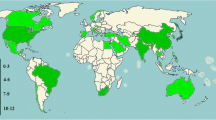Abstract
Cholera caused by Vibrio cholerae is a major public health problem among developing countries. The present study is designed to understand the occurrence of V. cholerae using conventional as well as molecular tools and antibiotic susceptibility testing of the isolated strains of V. cholerae from Muttil panchayat in district Wayanad of Kerala, India. This study was undertaken for a period of 12 months i.e., from April 2014 to March 2015. Out of 60 water samples collected from stream, 38 (63.3 %) were found positive for V. cholerae by conventional methods and among these, 21 (35 %) samples were found positive by PCR. However, none of the water samples (well water, household drinking water and pipeline water) yielded V. cholerae. The presence of V. cholerae was observed in the soil and stream from residential area and were also isolated from fish samples as well as from human stool samples. The antibiotic susceptibility testing of the isolates of V. cholerae obtained from different types of samples exhibited 100 % resistance to the antibiotics under study except for doxycycline. Furthermore, on correlating the physical parameters of the water samples collected with the isolation of V. cholerae, it was found that optimum temperature, increased pH and salinity in the present study favoured the survival of V. cholerae, along with high biochemical oxygen demand values of the water samples. The present study provides a baseline data to devise rapid and reliable molecular detection methods for V. cholerae and thereby attaining concrete molecular epidemiological surveillance.



Similar content being viewed by others
References
Faruque SM, Nair GB (2002) Molecular ecology of toxigenic Vibrio cholerae. Microbiol Immunol 46:59–66
Kaper JB, Morris JG, Levine MM (1995) Cholera. Clin Microbiol Rev 8:48–86
Goel AK, Jain M, Kumar P, Jiang SC (2010) Molecular characterization of Vibrio cholerae outbreak strains with altered El Tor biotype from southern India. World J Microbiol Biotechnol 26:281–287. doi:10.1007/s11274-009-0171-7
Ramamurthy T, Sharma NC (2014) Cholera outbreaks in India. Curr Top Microbiol Immunol 379:49–85
Centre for Disease Control and Prevention (CDC) (2014) Non-O1 and non-O139 Vibrio cholerae infections. http://www.cdc.gov/cholera/non-01-0139-infections.html. Accessed 05 June 2015
Sarkar BL, Kanungo S, Nair GB (2012) How endemic is cholera in India? Indian J Med Res 135:246–248
Thomas S, Ramachandran D, Remani B, Singh DV (2008) Detection and molecular characterization of Vibrio cholerae O1 Inaba biotype El Tor strain in Kerala, S. India. World J Microbiol Biotechnol 24:433–434
Kumar P, Peter WA, Thomas S (2008) Detection of virulence genes in Vibrio cholerae isolated from aquatic environment in Kerala, Southern India. Appl Biochem Biotechnol 151:256–262
O’Neill J (2014) Review on antimicrobial resistance. Antimicrobial resistance: tackling a crisis for the health and wealth of nations. HM Government, London, UK. http://amr-review.org/ Accessed 11 Dec 2014
Jagadeeshan S, Kumar P, Abraham WP, Thomas S (2009) Multi-resistant Vibrio cholerae non-O1/non-O139 from waters in South India: resistance patterns and virulence-associated gene profiles. J Basic Microbiol 49:538–544
Kumar P, Peter WA, Bhai R, Thomas S (2010) Characterization of an SXT variant Vibrio cholerae O1Ogawa isolated from a patient in Trivandrum, India. FEMS Microbiol Lett 303:132–136
Smith HL (1970) A presumptive test for vibrios: the “string” test. Bull World Health Org 42:817–818
Tarr CL, Patel JS, Puhr ND, Sowers E, Bopp CA, Strockbine NA (2007) Identification of Vibrio isolates using a multiplex PCR assay and rpoB sequence determination. J Clin Microbiol 45:134–140
Clinical Laboratories Standards Institute (CLSI) (2012) Guidelines performance standards for antimicrobial susceptibility testing; twenty-second informational supplement, vol 32, no 3, p 186
Bauer AW, Kirby WM, Sheris JC, Turck M (1966) Antibiotic susceptibility testing by a standardized single disc method. Am J Clin Pathol 45:149–158
Mishra A, Taneja N, Sharma M (2011) Environmental and epidemiological surveillance of Vibrio cholera in a cholera-endemic region in India with freshwater environs. J Appl Microbiol 112:225–237
Thomson CJ, Jesudason MV, Balaji V, Malathi B, Mukundan U, Amyes SGB (1998) The prevalence of Vibrio spp. in drinking water and environmental samples in Vellore South India. Epidemiol Infect 121:67–76
Hsiao A, Ahmed AMS, Subramanian S, Griffin NW, Drewry LL, Petri WA, Haque R, Ahmed T, Gordon JI (2014) Members of the human gut microbiota involved in recovery from Vibrio cholerae infection. Nature 515(7527):423–426
Carraro V, Sanna C, Brandas V, Sanna A, Pinna A, Coroneo V (2015) Hygiene and health risks associated with the consumption of edible lamellibranch molluscs Int. J Food Microbiol 201:52–57
Sabeena F, Thrivikramji G, Radhakutty G, Indu P, Singh DV (2001) In vitro susceptibility of Vibrio cholerae O1 biotype E1 Tor strains associated with an outbreak of cholera in Kerala, Southern India. J Antimicrob Chemother 47:361–362
Huq A, West PA, Small EB, Huq MI, Colwell RR (1984) Influence of water temperature, salinity, and pH on survival and growth of toxigenic Vibrio cholerae serovar 01 associated with live copepods in laboratory microcosms. Appl Environ Microbiol 48(2):420–424
Acknowledgments
The authors thank Dean, College of Veterinary and Animal Sciences, Pookode for extending the required facilities for conducting this study. The present study was carried out under the financial assistance obtained from State Plan Fund for the project entitled “Epidemiological study of Vibrio cholerae from water sources to provide healthy living environment at Aduvadi village (Muttil Panchayat, Wayanad District)” to the Kerala Veterinary and Animal Sciences University, Pookode during 2014–2015. The technical assistance provided by Mr. Balraj, Junior Health Inspector is duly acknowledged.
Author information
Authors and Affiliations
Corresponding author
Ethics declarations
Conflict of interest
None.
Rights and permissions
About this article
Cite this article
Mathews, E.B., Sunil, B., Prejit, N. et al. Occurrence and Antibiotic Susceptibility Testing of Vibrio cholerae from District Wayanad, Kerala, India. Proc. Natl. Acad. Sci., India, Sect. B Biol. Sci. 88, 673–678 (2018). https://doi.org/10.1007/s40011-016-0799-7
Received:
Revised:
Accepted:
Published:
Issue Date:
DOI: https://doi.org/10.1007/s40011-016-0799-7




